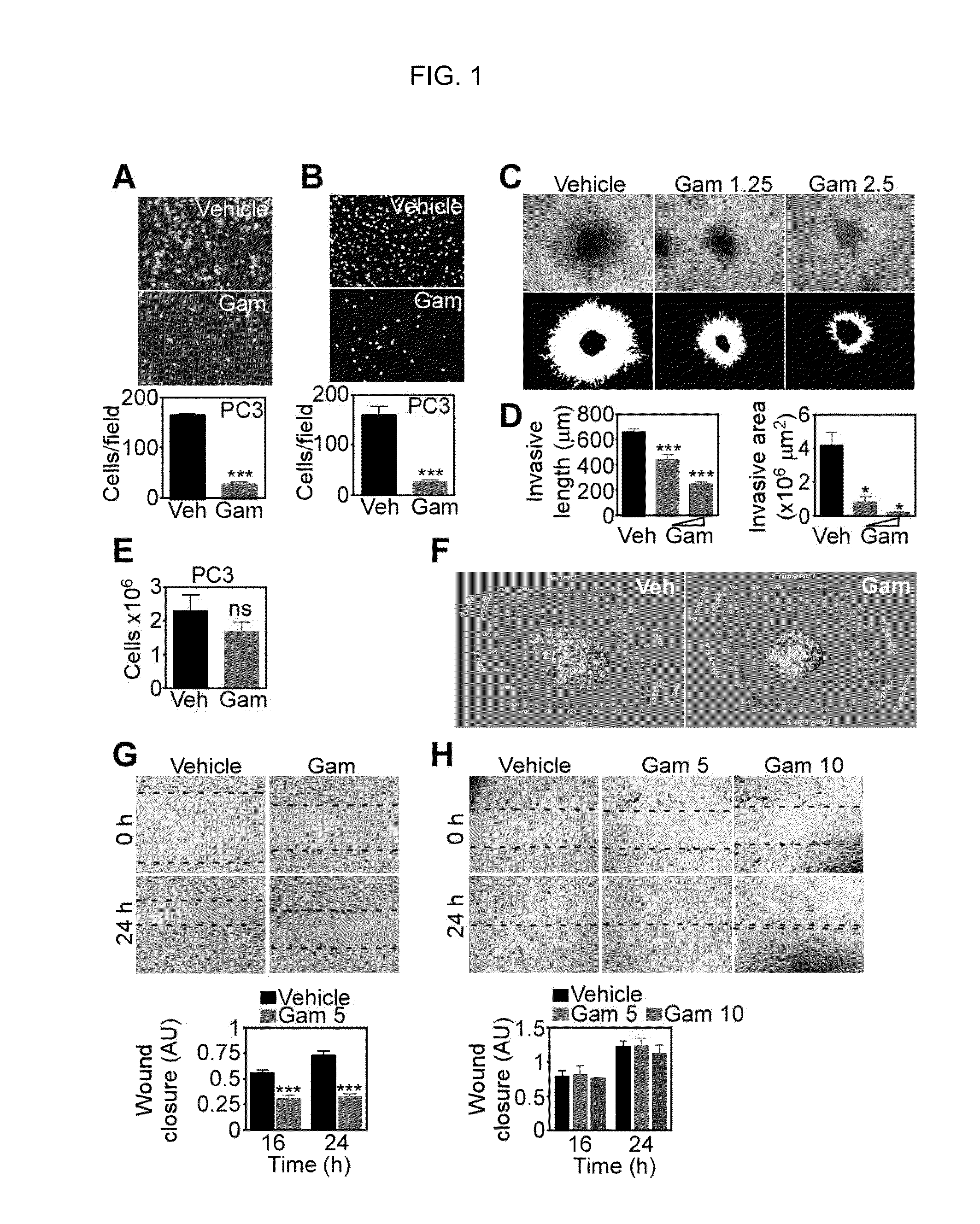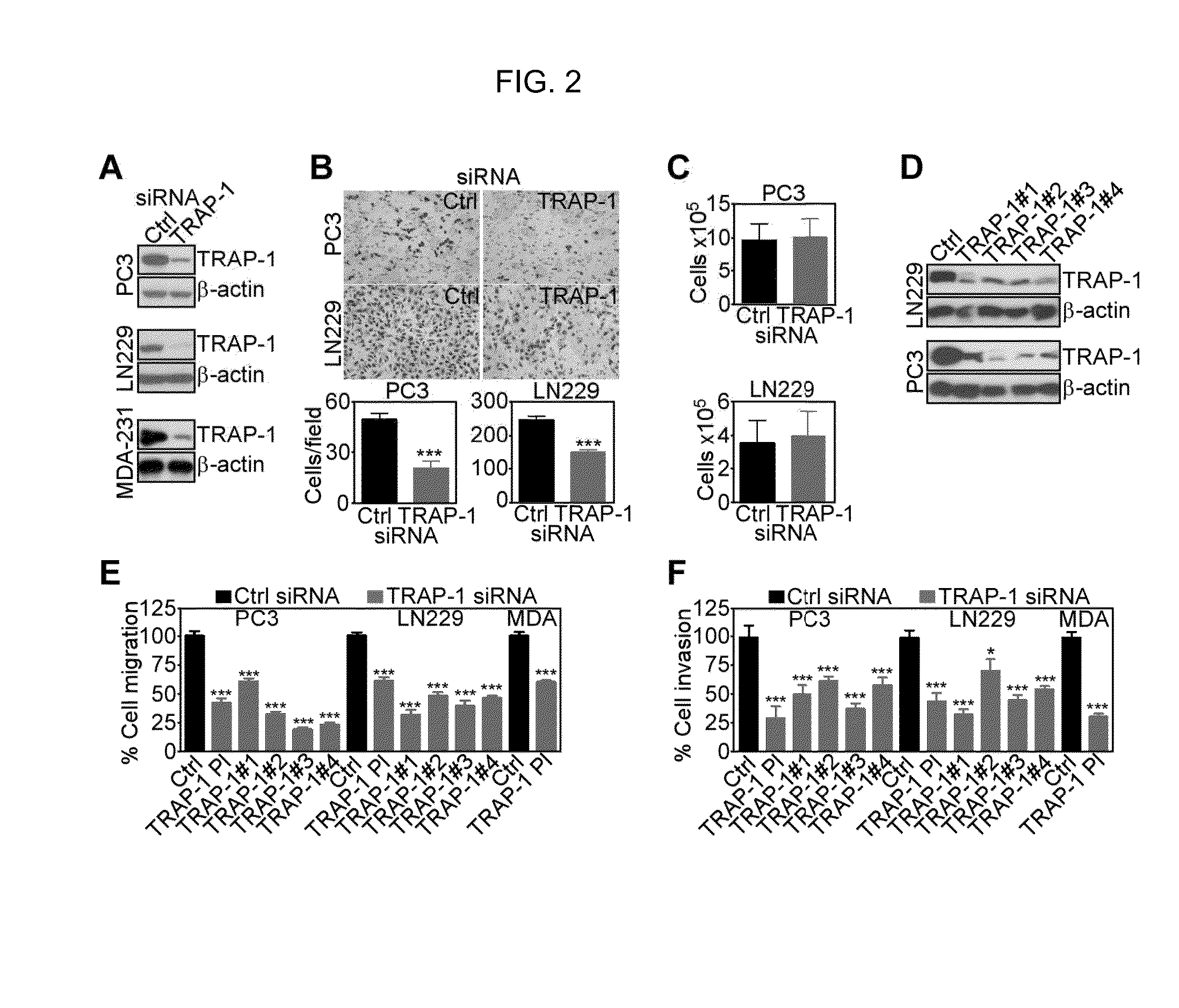Methods and Compositions for Neoadjuvant Therapy
a neoadjuvant therapy and composition technology, applied in the field of methods and compositions for neoadjuvant therapy, can solve the problems of unclear regulation of this process, side effects that can affect the patient's health and immune status, and inability to clearly explain the process, so as to inhibit fak-directed tumor cell motility and metastasis, reduce atp production, and inhibit mitochondrial oxidative phosphorylation.
- Summary
- Abstract
- Description
- Claims
- Application Information
AI Technical Summary
Benefits of technology
Problems solved by technology
Method used
Image
Examples
example 1
Materials and Methods
[0064]Cell Culture.
[0065]Human glioblastoma LN229, prostate adenocarcinoma PC3 and PC3-ML subline, lung adenocarcinoma H1299, H1437, H460 and A549, breast adenocarcinoma MDA-MB-231, melanoma 1205Lu and WM793, or normal NIH3T3 and MRC-5 fibroblasts were obtained from the American Tissue Culture Collection (ATCC), and maintained in culture according to the supplier's specifications. For metabolic stress experiments, cells were incubated in MEM-based media containing glucose, essential and non-essential amino acids and vitamins in identical concentration as DMEM, plus 4 mM L-glutamine, 1 mM sodium pyruvate, 10 mM HEPES, and 10% 10 K dialyzed FBS (Gibco). Three conditions were tested: 25 mM glucose (complete medium), 5 mM glucose or 50% amino acid deprivation compared to DMEM. Galactose challenge experiments were performed by culturing the cells in DMEM No Glucose medium supplemented with 4 mM L-glutamine, 10% 10K dialyzed FBS and the indicated mixtures of D-(+)-glu...
example 2
Mitochondrial Hsp90 Regulation of Tumor Cell Motility
[0104]To begin investigating a role of mitochondrial Hsp90s in tumor cell movements, we used Gamitrinib (GA mitochondrial matrix inhibitor), a small molecule Hsp90 ATPase antagonist engineered to accumulate selectively in mitochondria (24). In these experiments, non-cytotoxic concentrations of Gamitrinib (23) suppressed the migration (FIG. 1A; FIG. 10A), and invasion (FIG. 1B; FIG. 10B) of tumor cell types. When tested in a more physiologic, 3-D model of cellular motility, Gamitrinib blocked tumor cell invasion in organotypic spheroids embedded in a collagen matrix (FIG. 1C), as evidence by nearly complete suppression of invasive length and invasive areas (FIG. 1D). In control experiments, Gamitrinib did not reduce tumor cell proliferation, compared to vehicle-treated cultures cells (FIG. 1E). Overall cell viability in a 3-D microenvironment was also not affected, by calcein-AM staining and 2-photon microscopy imaging of organotyp...
example 3
Cellular Requirements of Mitochondrial Hsp90 Control of Tumor Cell Motility
[0106]Consistent with inhibition of cell motility, exposure of tumor cells to Gamitrinib suppressed actin cytoskeletal assembly, with appearance of a rounded cell morphology, devoid of stress fibers and filopodia, by fluorescence microscopy (FIG. 11). Accordingly, Gamitrinib treatment resulted in nearly complete loss of cytoskeletal lamella dynamics as evidenced by single cell, time-lapse videomicroscopy analysis (FIG. 3A-C; FIG. 12A-12C), with profound inhibition of ruffling frequency and retraction speed in tumor cells (FIG. 3D). When analyzed for biochemical markers of cell motility, Gamitrinib-treated tumor cells exhibited loss of phosphorylation of Focal Adhesion Kinase (FAK) (25) on its auto-phosphorylation site, Tyr397 (26), and Src-phosphorylation site, Tyr925 (27) (FIG. 3E). Gamitrinib also inhibited the phosphorylation of other cell motility kinases, including Src on Tyr416 (FIG. 3E), and of group I...
PUM
| Property | Measurement | Unit |
|---|---|---|
| pH | aaaaa | aaaaa |
| diameter | aaaaa | aaaaa |
| thickness | aaaaa | aaaaa |
Abstract
Description
Claims
Application Information
 Login to View More
Login to View More - R&D
- Intellectual Property
- Life Sciences
- Materials
- Tech Scout
- Unparalleled Data Quality
- Higher Quality Content
- 60% Fewer Hallucinations
Browse by: Latest US Patents, China's latest patents, Technical Efficacy Thesaurus, Application Domain, Technology Topic, Popular Technical Reports.
© 2025 PatSnap. All rights reserved.Legal|Privacy policy|Modern Slavery Act Transparency Statement|Sitemap|About US| Contact US: help@patsnap.com



